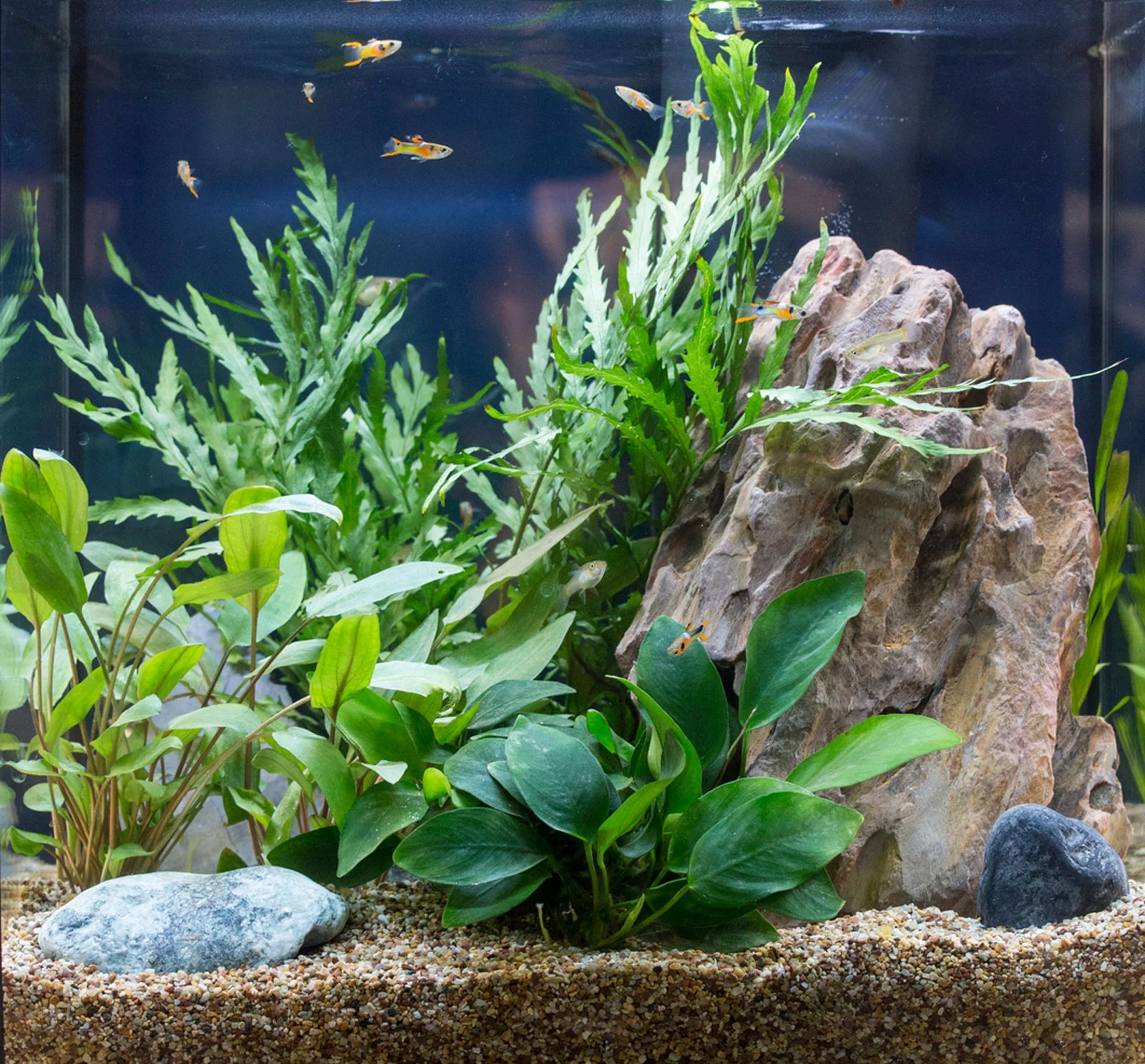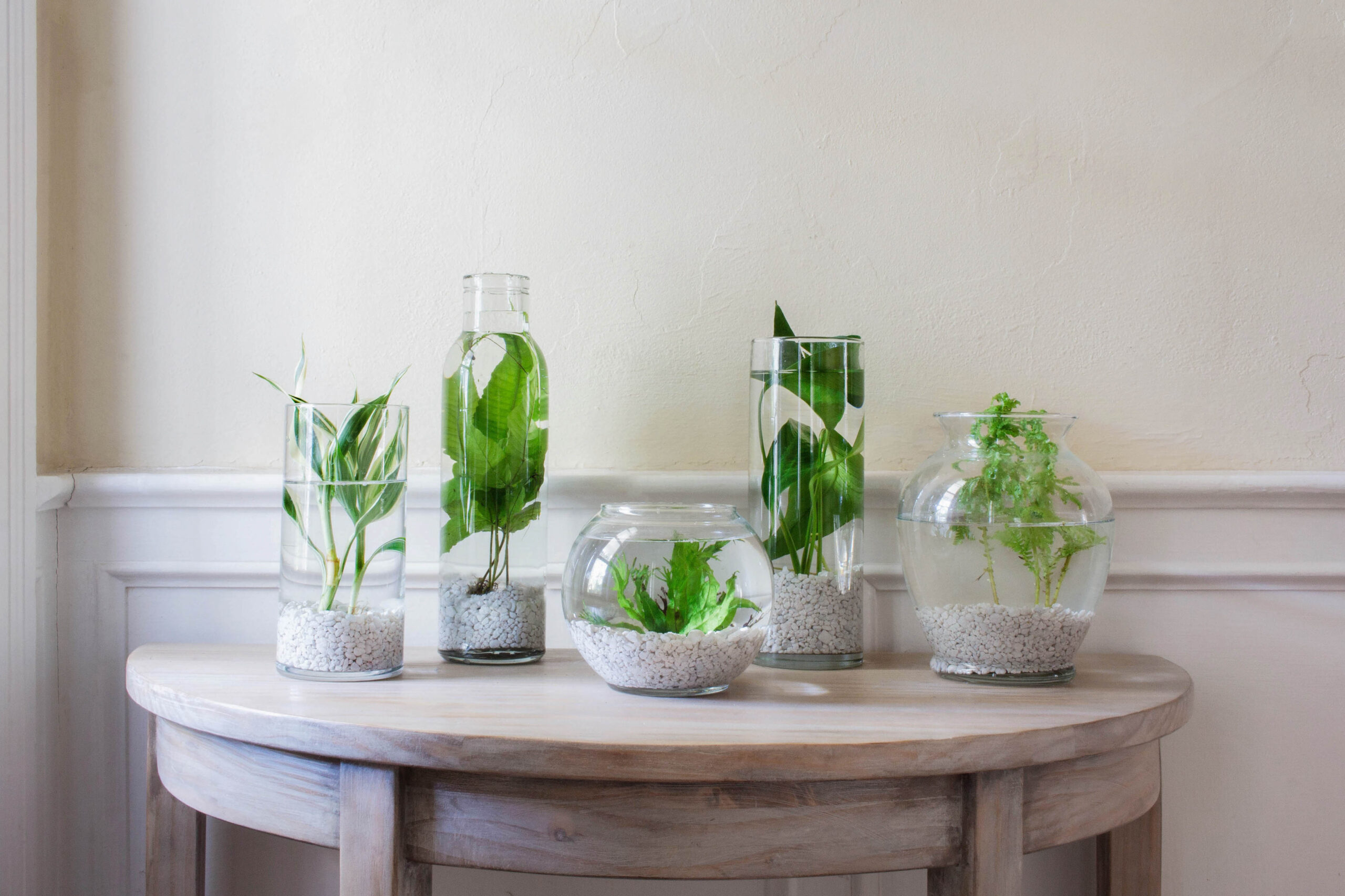Java Fern Underwater Plants For Water Gardens

Those of us who love aquariums to enjoy the fish swimming have an unusual outlet for gardening right in front of us. Growing Java Fern in our aquariums is a great way to bring in greenery. Plus, your underwater animals will love it!
Dark green in color, these aquarium plants are a perfect backsplant for an aquarium, as they can grow to over 13″ tall. The swaying leaves provide cover for your aquatic inhabitants, as well as a pop of color in an otherwise dull tank.
Native to Thailand, parts of China and Malaysia, Microsorum pteropus is a variable plant that loves water. In the wild, it grows both submerged in water and partially above the surface, in swampy areas or along streams.
These plants consist of three basic parts: a root system, a rhizome and leaves.
Dark brown tendril-like roots are used to attach the plant to the chosen medium. It doesn’t use its root system to absorb nutrients as much as it does to just hold on, and these super-thin hair-like tendrils do a great job of that.
This rhizome forms the base of the plant and absorbs most of the plant’s needed nutrition from the water around it. Over time, the rhizome will grow to cover any object the plant has clung to and can easily expand to a maximum of 6″ wide.
Dark green leathery leaves make up the rest of the plant. Their shape varies depending on the origin of the plant and growing conditions. The leaves also form the reproductive part of the plant, as they can form spores and develop seedlings directly on the surface of the leaves.
Although the length of the leaves is somewhat variable, they often reach 13″ or more in length, so they are often used towards the back of an aquarium.
This is sometimes called the “lace java fern” because of its thin leaf shape. Delicate and feathery, the windelov variety can be used in combination with broad-leaved varieties for visual appeal. Due to its thinner leaves, it is also a shorter plant.

The wavy is an interesting variety because the leaves are almost the opposite of the leaf shape of the narrow variety. The pointed tips widen significantly on the upper part of the leaf, then gradually decrease until the Leaf disappears at the base in the rhizome.
Care of the Java Fern
Considered one of the easiest aquarium plants to grow, the Java Fern is a fantastic addition to your planted aquarium. But it is different from many other types of plants. Let’s talk about the conditions for caring for your java Fern and how to keep it healthy and lush!
Light and temperature
Although many plants love sunlight, your Java Fern microsorum is actually a low-light plant. Too much sun and the leaves of your plant will burn. This can cause the appearance of brown spots or, in very severe matters, the leaves will become transparent and begin to dissolve.
A reasonable rule of thumb is to aim for 1.5 watts of soft lighting for every liter of water in the tank, using small incandescent or soft fluorescent lamps. If this still seems too much, consider lighting the tank with low-light LEDs and reducing your top lighting even more.
In terms of temperature, these plants like temperatures between 70 and 75 degrees, but can tolerate anything between 60 and 83 degrees Fahrenheit.
Water and humidity
Since the Java Fern microsorum is an aquatic plant that can grow completely immersed in a planted aquarium, it’s safe to say that it loves moisture! This is true regardless of whether it is completely or partially submerged, and the root system and rhizome must be in constant contact with water for optimal growth.
In general, it will grow if it is completely immersed in an aquarium or pond, although the tips of the leaves can rise above the surface of the water. If too much of the leaf surface is exposed to the air, it may need additional nutrients to maintain itself properly.
The fern microsorum pteropus can survive by living in brackish and salt water, but prefers fresh water. The salt content should not exceed 1.00 g, as your plant may show signs of leaf melting at a higher salt content. The pH of your water should also be between 6 and 7.5.

It is important to change 25% of the water in your aquarium every 2 weeks to remove excess nutrients or fish waste and keep the water fresh. Your Javanese Microsorum also likes oxygenated water, so aquariums with pump systems are ideal. It does not need as much CO2 as other aquatic plants.
Ground
In general, the most common growing medium for these aquarium plants is pieces of wood or large rocks. Occasionally it is attached to decorative elements made for fish ponds.
Instead of planting it in the substrate of the reservoir, it is advisable to fix your Java Fern on driftwood or rocks with a piece of cotton thread. This keeps the roots in contact with the growing medium until it can develop a firm grip and The Wire will eventually rot.
Fertilize
Aquatic plants need four basic nutrients to grow. These are iron, manganese, nitrogen and phosphorus. Sometimes additional micronutrients such as Copper, Zinc, Borate or molybdenum are also needed.
The fertilizer you want to use for these aquatic plants is a little different from a traditional fertilizer. Designed to be safe for both fish and plants, these are available in two different formats: liquid and tablet.
Alternatively, there are tablet-type aquarium fertilizers. These slow-release capsules are buried in the substrate of the reservoir and release their nutrients over time.
It takes some trial and error to figure out where to bury the capsule in the tank. While a liquid fish fertilizer spreads immediately into the water, tablet varieties do not always spread over the entire water supply of the reservoir.
Repot
With fern microsorum, repotting is more like securing and moving. Since the roots do not like to be buried, you can instead attach young seedlings to driftwood or rocks with cotton thread.

In doing so, be gentle. Do not tie the plants tightly, as this can damage the root structure. Instead, attach the rhizome loosely to the surface with the wire, making sure that the roots are in contact with the surface. The roots will cling in time if the wire rots in the water.
If possible, carry out this process in a bowl of fresh water. This keeps the plant moist and the movement of the water helps it to comfortably ventilate its roots.
Cut
Occasional light pruning promotes plant development. Remove the larger leaves just above the rhizome to give it more energy to spend on growth. Do not remove too many, but select only one or two of the largest leaves.
Pruning in this way will give a much larger plant in general over time, as the rhizome has enough time to develop a larger base from which leaf growth can be sent.
If melting of the Java Fern begins to appear, immediately remove the damaged leaves by pruning them just above the rhizome. See the issue segment below for more information on java fern melt, as well as other ways to stop the damage it causes.
Growing Problems
The black lines that cross the leaves of other plants can be a cause for concern, but for the Javanese this is quite normal. This plant can have dark colored veins on the inside of its leaves, depending on the variety it is. They can also form brown or black bumps that turn into seedlings.
However, if the leaves begin to turn completely black or a dull olive-green color, the plants scream for more nutrition. To solve this problem, use aquarium plant fertilizer according to the manufacturer’s instructions.
Pest
When we think of parasites, they are usually insects. But the Java Fern microsorum pteropus does not seem to attract insects. All it seems to attract are the snails that seem to like to live among the green foliage.
Although snails will not harm your java Ferns, from time to time you can find some small forms hanging from store-bought plants. But these snails can be a problem for the fish in your aquarium or for other aquatic plants that you may have.
